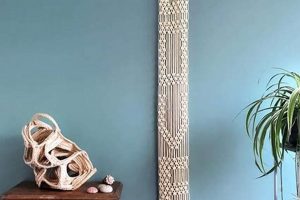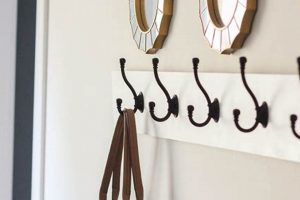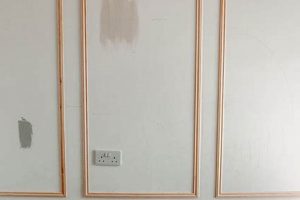The process of installing decorative strips to a wall’s surface by a homeowner is a project requiring precision and skill. This undertaking, often intended to enhance a room’s aesthetic appeal, involves careful measurement, cutting, and attachment of materials such as wood or composite polymers to create visually interesting borders or panels. For example, a homeowner might install chair rail or shadow boxes to add architectural detail to a dining room.
Implementing this type of home improvement project provides an avenue for personalization and cost savings. Historically, such embellishments were markers of affluence, but today, they are accessible to a wider range of homeowners through readily available materials and online resources. Furthermore, these additions can increase a property’s perceived value by contributing to its overall finished appearance and character.
The following sections will outline essential preparation steps, suitable material choices, various style options, tools needed, installation techniques, and considerations for finishing. Each of these elements plays a crucial role in achieving a professional and lasting result.
Essential Considerations for Decorative Wall Strip Installation
Achieving a professional-looking result when undertaking a wall ornamentation project requires careful planning and execution. The following tips provide guidance for ensuring a successful installation.
Tip 1: Precise Measurement is Paramount: Before commencing any cutting, meticulous measurements of the wall space are essential. Discrepancies can lead to visible errors and material waste. Utilize a laser level or a traditional level and measuring tape for accuracy.
Tip 2: Material Selection Impacts Durability and Aesthetics: Consider the environment and desired aesthetic when selecting materials. Solid wood offers a classic look but may be susceptible to moisture damage in certain climates. Composite materials provide moisture resistance and often require less maintenance.
Tip 3: Proper Tools Ensure Clean Cuts: Invest in quality tools, particularly a miter saw with a sharp blade, to achieve clean, precise cuts. A dull blade can splinter the material and create unsightly edges.
Tip 4: Adhesion Methods Vary: Determine the appropriate adhesive based on the material and wall surface. Construction adhesive offers a strong bond, but may not be suitable for all surfaces. Consider using finishing nails in conjunction with adhesive for added stability.
Tip 5: Careful Caulking Creates Seamless Transitions: Apply paintable caulk along all edges and seams to create a seamless, professional finish. Smooth the caulk with a wet finger or a specialized tool for a clean appearance.
Tip 6: Primer is Essential for Paint Adhesion: Before painting, apply a primer to the trim. Primer ensures proper paint adhesion and provides a uniform base for the topcoat, resulting in a more durable and aesthetically pleasing finish.
Tip 7: Consider Wall Texture: For textured walls, choose trim that will not highlight the unevenness. Wider trim pieces or those with more depth can help to minimize the visual impact of the texture.
By adhering to these tips, one can significantly improve the outcome of the project, resulting in an enhanced and refined living space. Accuracy and attention to detail are critical for achieving professional-quality results.
The subsequent section will address potential challenges and troubleshooting strategies for a seamless project completion.
1. Planning & Design
The “Planning & Design” phase forms the foundational element for any successful wall surface enhancement project. Initial decisions made during this phase directly influence the material selection, dimensional specifications, and overall aesthetic of the finished installation. A thorough design process necessitates a comprehensive evaluation of the existing space, including architectural style, room dimensions, and ambient lighting. For example, a room with low ceilings may benefit from vertically oriented stripes, which visually elongate the wall, whereas a large, open space can accommodate more elaborate paneling designs. Neglecting this initial planning can lead to mismatched proportions, incompatible styles, and increased material waste.
Effective planning also requires a detailed assessment of the project’s scope and complexity. A straightforward chair rail installation demands less intricate design work compared to a multi-layered shadow box arrangement. The design phase should produce detailed sketches, measurements, and material lists to guide subsequent steps. Moreover, understanding the desired visual effect, whether contemporary minimalism or traditional grandeur, dictates the appropriate selection of molding profiles, colors, and finishes. A common misstep is failing to consider the interplay between wall color, trim color, and existing furniture, resulting in a visually disjointed space.
In summation, meticulous “Planning & Design” significantly impacts the final result of a “diy wall trim molding” endeavor. From optimizing spatial perception to streamlining material procurement, a well-defined design roadmap mitigates potential errors and ensures a cohesive, visually pleasing outcome. Overlooking this crucial initial phase compromises the project’s success and diminishes its capacity to enhance the intended space. Careful thought, research, and a clear vision are essential to transforming a concept into a tangible, aesthetically rewarding reality.
2. Material Selection
Material Selection is a critical determinant in any decorative wall strip installation project. The chosen material impacts not only the aesthetic outcome but also the longevity, maintenance requirements, and overall cost-effectiveness of the installation. Thoughtful consideration of material properties is therefore essential for a successful outcome.
- Wood Species and Characteristics
Different wood species offer varying levels of durability, grain patterns, and susceptibility to moisture. Softwoods like pine are more affordable and easier to work with, but hardwoods like oak or maple provide greater resistance to dents and scratches. The choice of wood should align with the intended visual style and the environmental conditions of the space. For instance, in bathrooms, moisture-resistant options are paramount. Unsuitable species can lead to warping, cracking, or decay, diminishing the installation’s lifespan.
- Composite Materials: MDF and Polymer Options
Medium-density fiberboard (MDF) presents a smooth, uniform surface ideal for painting and is less prone to warping than solid wood. Polymer options, such as PVC, offer exceptional moisture resistance and are suitable for areas with high humidity. However, composite materials may lack the natural aesthetic appeal of solid wood and may not be as easily repairable. Furthermore, certain composite materials may release volatile organic compounds (VOCs), necessitating careful selection and proper ventilation during installation.
- Cost Implications and Budget Considerations
Material costs can significantly vary depending on the chosen type. Solid hardwoods are generally more expensive than softwoods or composite materials. Budgetary constraints often influence material selection, prompting homeowners to explore more affordable alternatives. However, it is important to consider the long-term costs associated with maintenance and replacement. Selecting a cheaper material that requires frequent repairs may ultimately be less cost-effective than investing in a more durable option initially.
- Tool Compatibility and Ease of Installation
Different materials require different tools and techniques for cutting, shaping, and attaching. Softwoods are typically easier to cut and nail than hardwoods. Composite materials may require specialized blades to prevent splintering. The homeowner’s skill level and access to appropriate tools should inform the material selection process. Attempting to work with a material that requires advanced skills or specialized equipment can lead to frustration and subpar results.
These material considerations must be viewed holistically. While aesthetic preferences play a key role, functional requirements, budgetary constraints, and installation capabilities must also be weighed. Informed “Material Selection” ensures that the finished “diy wall trim molding” project achieves the desired visual impact while also providing lasting value and minimizing potential complications.
3. Precise Measurement
Precise measurement forms the bedrock of any successful decorative wall strip installation endeavor. Inaccurate measurements directly propagate errors throughout the entire project, leading to material waste, misaligned seams, and an overall unprofessional appearance. The relationship between diligent measurement and a quality finished product is causative; the former directly determines the latter’s success. For example, if a wall section is measured inaccurately by even a quarter of an inch, this discrepancy, when multiplied across several sections, can result in a visible gap or overlap at the corners or where the trim meets other architectural features. The practical significance of understanding this connection lies in minimizing costly mistakes and ensuring a refined aesthetic.
The application of precise measurement extends beyond simply determining the length of each trim piece. It encompasses accurate determination of angles, especially for mitered corners, and consistent marking of reference lines to ensure level and even placement. The use of tools such as laser levels and digital angle finders can significantly enhance accuracy. Consider the scenario where a chair rail is being installed around a room. If the initial height measurement is inconsistent, the resulting installation will appear visually skewed, regardless of the quality of the materials or the skill of the installer. This example highlights the importance of establishing a reliable baseline and maintaining consistent measurements throughout the entire process. Furthermore, precise measurement includes accounting for minor imperfections in the wall itself, such as slight bowing or uneven surfaces.
In conclusion, the correlation between meticulous measurement and successful wall surface enhancements cannot be overstated. Inadequate attention to this foundational element undermines the entire project. The challenges associated with imprecise measurements extend beyond aesthetic flaws to encompass increased costs, wasted time, and potential frustration. Therefore, a thorough understanding and diligent application of precise measurement techniques are essential prerequisites for achieving a professional-quality, visually appealing decorative trim installation.
4. Cutting Accuracy
Attaining dimensional precision in the preparation of decorative wall strips is fundamentally reliant on cutting accuracy. The degree to which cuts conform to specified measurements and angles directly influences the fit, finish, and overall aesthetic quality of the installed ornamentation. Deficiencies in cutting precision necessitate rework, increase material waste, and diminish the visual impact of the finished project.
- Mitering for Seamless Corner Transitions
The creation of seamless corner transitions relies on accurate miter cuts, typically at a 45-degree angle. Deviations from this angle result in visible gaps or overlaps at the corners, compromising the aesthetic integrity of the trim work. A miter saw with a sharp blade and stable platform is essential for achieving the necessary accuracy. Precision in this step ensures the visual continuity of the trim around the room.
- Straight Cuts for Consistent Lengths
Consistent lengths of trim pieces are crucial for maintaining visual balance and uniformity, particularly in horizontal applications such as chair rails or baseboards. Straight cuts must be perpendicular to the edge of the material to prevent gaps or misalignment along the wall. Utilizing a guide, such as a speed square, in conjunction with a sharp saw blade, is recommended for achieving accurate straight cuts.
- Accounting for Material Thickness and Kerf
The thickness of the trim material and the kerf (width of the saw blade’s cut) must be factored into the cutting calculations to ensure accurate final dimensions. Failure to account for these factors can result in trim pieces that are either too short or too long, necessitating further adjustments or replacements. Precise measurements and awareness of material properties are crucial for avoiding such errors.
- Impact of Cutting Precision on Overall Project Cost
Inaccurate cuts lead to material waste and necessitate the purchase of additional supplies. Moreover, the time spent correcting errors or re-cutting pieces increases labor costs. Investing in quality cutting tools and taking the time to ensure accurate cuts reduces both material and labor expenses, contributing to a more cost-effective overall project.
The convergence of precise mitering, accurate straight cuts, accounting for material properties, and cost considerations underscores the pivotal role of cutting accuracy in achieving a professional-quality decorative wall strip installation. Substandard cutting practices detract from the intended aesthetic appeal and introduce unnecessary expenses. Adherence to meticulous cutting techniques is therefore paramount for successful project execution.
5. Secure Attachment
The long-term success of any decorative wall strip installation is intrinsically linked to the method of securement employed. The choice of attachment technique and materials directly influences the stability, appearance, and longevity of the trim work. Effective securement prevents shifting, sagging, or detachment of the strips, ensuring that the installation withstands environmental factors and maintains its aesthetic integrity over time.
- Adhesive Selection and Surface Compatibility
The selection of an appropriate adhesive is paramount. Construction adhesives offer robust bonding capabilities, but their compatibility with both the trim material and the wall surface must be carefully evaluated. Porous surfaces, such as drywall, require adhesives specifically formulated for such applications. Non-porous surfaces, such as painted walls, may necessitate surface preparation, such as sanding, to enhance adhesion. Incorrect adhesive selection can lead to premature failure of the bond and detachment of the trim. For example, using a water-based adhesive on a non-porous surface could result in inadequate adhesion and eventual separation.
- Mechanical Fasteners: Nails and Screws
Mechanical fasteners, such as nails and screws, provide additional reinforcement and are particularly useful for securing heavier trim pieces or for installations where adhesive alone is insufficient. The length and type of fastener must be appropriate for the thickness of the trim and the wall material. Finish nails, designed to minimize visibility, are often used for delicate trim work. Screws offer greater holding power but may require pre-drilling to prevent splitting the trim. For example, when installing crown molding, screws may be necessary to ensure secure attachment to wall studs.
- Combination of Adhesives and Fasteners
The most reliable securement method often involves a combination of adhesives and mechanical fasteners. Adhesive provides immediate bonding and helps to distribute stress evenly, while fasteners offer long-term stability and prevent movement. This approach is particularly effective for larger trim pieces or installations in high-traffic areas. The adhesive serves as the primary bonding agent, while the fasteners provide a fail-safe mechanism in case the adhesive bond weakens over time. This combined approach can safeguard the installation against environmental stressors and physical impact.
- Proper Spacing and Distribution of Fasteners
The spacing and distribution of fasteners are critical for ensuring uniform securement. Fasteners should be spaced evenly along the length of the trim, with closer spacing in areas that are subject to higher stress or movement. Corner joints and areas where the trim transitions between different wall surfaces are particularly prone to stress and require closer fastener spacing. Failure to properly space and distribute fasteners can result in uneven securement, leading to warping, cracking, or detachment of the trim. A balanced approach is key to preserving the trim’s integrity and appearance.
These facets underscore the crucial relationship between effective securement techniques and the enduring success of decorative wall surface enhancement projects. The careful selection of appropriate adhesives and fasteners, coupled with proper installation techniques, directly contributes to a stable, visually appealing, and long-lasting result. The ultimate aim is to ensure that the implemented trim not only enhances the aesthetic value of the space but also remains securely attached, thereby maintaining its intended appearance and function over time.
6. Seamless Finishing
Achieving an uninterrupted visual plane between decorative wall strips and the underlying wall surface is paramount for a professional aesthetic. The pursuit of “Seamless Finishing” represents a critical stage in surface enhancement projects, significantly impacting the perceived quality and sophistication of the installation.
- Caulking Techniques for Gap Elimination
The application of paintable caulk along all seams, joints, and intersections serves to eliminate visible gaps and create a unified appearance. The selection of a caulk that is compatible with both the trim material and the wall paint is crucial for ensuring proper adhesion and preventing cracking. The proper execution involves a smooth, consistent application of caulk, followed by careful tooling to create a seamless transition. For instance, a poorly caulked seam can detract from the overall aesthetic, regardless of the quality of the trim itself.
- Sanding and Surface Preparation for Uniform Texture
Prior to painting, meticulous sanding of the trim surface is essential for creating a uniform texture and promoting optimal paint adhesion. Imperfections, such as minor dents or scratches, should be addressed through sanding and filling with wood filler as necessary. Furthermore, proper surface preparation involves cleaning the trim to remove any dust, dirt, or grease that could impede paint adhesion. Failing to properly prepare the surface can result in an uneven paint finish and reduced durability. For example, residual sanding dust can create a textured surface, even after painting.
- Priming for Optimal Paint Adhesion and Coverage
The application of a primer coat serves to seal the trim surface, promote optimal paint adhesion, and ensure uniform color coverage. Primer is particularly important for porous materials, such as wood, which can absorb paint unevenly. A high-quality primer can also block stains and prevent bleed-through from underlying materials. The selection of a primer that is compatible with the topcoat paint is crucial for achieving a durable and long-lasting finish. Skipping the priming step can result in poor paint adhesion, uneven color, and the need for multiple coats of paint.
- Painting Techniques for a Flawless Finish
The application of paint should be performed using techniques that minimize brush strokes, roller marks, and drips. Multiple thin coats of paint are generally preferable to a single thick coat, as they provide better coverage and reduce the risk of runs. The use of high-quality brushes and rollers, along with proper paint thinning, can contribute to a smoother, more even finish. Furthermore, proper ventilation is essential for preventing the buildup of paint fumes and ensuring optimal drying conditions. For example, using a low-quality brush can leave visible brush strokes on the trim surface, detracting from the desired seamless finish.
The culmination of effective caulking, sanding, priming, and painting techniques yields a “Seamless Finishing” that elevates the visual impact of wall enhancement projects. Each facet, when executed with precision, contributes to a unified and refined aesthetic, reinforcing the value and sophistication of such enhancements. Overlooking any one of these vital facets ultimately compromises the desired visual outcome, underscoring the necessity of a holistic approach to ensuring a high-quality result.
7. Surface Preparation
The initial phase of any decorative wall strip installation centers on meticulous surface preparation. A well-prepared surface provides the essential foundation for secure adhesion, optimal paint finish, and long-term durability, impacting the overall aesthetic and longevity of the installed trim.
- Cleaning and Degreasing
The removal of dirt, dust, grease, and other contaminants from the wall surface is paramount. Such impurities impede adhesive bonding and can compromise the integrity of the paint finish. A thorough cleaning process often involves washing the wall with a mild detergent solution, followed by rinsing with clean water and allowing the surface to dry completely. In kitchens or bathrooms, where grease accumulation is common, a degreasing agent may be necessary. Neglecting this step can result in peeling paint, adhesive failure, and an overall unprofessional appearance. For instance, trim installed on a greasy kitchen wall may detach within a short period.
- Repairing Imperfections: Filling Holes and Cracks
Addressing imperfections, such as holes, cracks, and uneven surfaces, is crucial for creating a smooth and uniform substrate for the trim. Small holes can be filled with spackle or joint compound, while larger cracks may require patching with drywall tape. The filled areas should be sanded smooth to blend seamlessly with the surrounding wall surface. Failure to repair these imperfections can result in visible bumps or distortions in the finished trim installation. For example, trim installed over an unpatched hole will likely exhibit an unsightly indentation.
- Sanding for Optimal Adhesion
Sanding the wall surface, particularly if it is glossy or painted with a high-sheen finish, creates a slightly roughened texture that enhances adhesive bonding. Sanding also helps to remove loose paint or debris that could compromise adhesion. A medium-grit sandpaper is typically used for this purpose, followed by wiping the wall clean to remove any sanding dust. Skipping the sanding step can lead to poor adhesive bond and eventual detachment of the trim, especially in areas subject to high humidity or temperature fluctuations. As an illustration, the bond between trim and wall will be weak. And this can be addressed by sanding the area.
- Priming for Uniform Absorption and Paint Adhesion
Applying a primer coat serves to seal the wall surface, promote uniform paint absorption, and enhance the adhesion of subsequent paint layers. Primer is particularly important for porous surfaces, such as drywall, which can absorb paint unevenly. A high-quality primer can also block stains and prevent bleed-through from underlying materials. The selection of a primer that is compatible with the topcoat paint is crucial for achieving a durable and long-lasting finish. Failing to prime the surface can result in uneven paint coverage, poor adhesion, and the need for multiple coats of paint.
The individual steps of cleaning, repairing, sanding, and priming the surface are all inextricably linked to the overall success of “diy wall trim molding.” Each provides a distinct advantage. It can also promote the project’s longevity. Inadequacies in any one of these can result in noticeable imperfections. It can also detract from the visual appeal of the project. And it can also jeopardize the project’s integrity. Therefore, a meticulous approach is essential.
Frequently Asked Questions
This section addresses common inquiries concerning the process of installing decorative strips on wall surfaces. The information provided aims to clarify fundamental aspects of this type of home improvement project.
Question 1: What is the typical lifespan of decorative wall trim, and what factors influence its durability?
The lifespan of decorative wall trim varies considerably depending on the material composition and environmental conditions. Solid wood trim, when properly sealed and maintained, can last for decades. Composite materials, such as PVC, offer resistance to moisture and may also exhibit extended lifespans. Factors influencing durability include humidity levels, exposure to direct sunlight, and the quality of the initial installation, including securement and finishing.
Question 2: Are specialized tools required for installing decorative wall trim, or can standard woodworking tools be used?
While some projects can be accomplished with standard woodworking tools, the precision and efficiency of specialized tools are often advantageous. A miter saw is essential for creating accurate angled cuts, particularly for corner transitions. A laser level can assist in ensuring horizontal and vertical alignment. A pneumatic nail gun expedites the attachment process. While not strictly required, these specialized tools can enhance the quality and speed of the installation.
Question 3: What are the common mistakes to avoid when installing decorative wall trim?
Common errors include inaccurate measurements, improper miter cuts, insufficient adhesive application, and inadequate surface preparation. Failing to account for the thickness of the trim or the kerf of the saw blade can lead to dimensional discrepancies. Neglecting to sand or prime the wall surface can compromise paint adhesion. Rushing the installation process often results in avoidable mistakes.
Question 4: Is it necessary to hire a professional installer, or can a homeowner with limited experience successfully complete a decorative wall trim project?
The feasibility of a homeowner undertaking this project depends largely on their skill level and the complexity of the intended design. Simple installations, such as baseboard or chair rail, may be within the capabilities of a reasonably skilled homeowner. More intricate designs or installations involving complex angles or unusual wall conditions often benefit from the expertise of a professional installer.
Question 5: What are the cost implications of choosing different materials for decorative wall trim?
Material costs can vary significantly. Solid hardwoods, such as oak or maple, are generally more expensive than softwoods like pine or composite materials like MDF. The choice of material should be balanced against budgetary constraints, aesthetic preferences, and functional requirements. While less expensive materials may initially reduce costs, the long-term expenses associated with maintenance and replacement should also be considered.
Question 6: How does the existing wall texture impact the installation and finishing of decorative wall trim?
Existing wall texture can present challenges for achieving a seamless finish. Heavily textured walls may require additional preparation, such as skim coating, to create a smoother surface for the trim. The choice of trim profile can also be influenced by the wall texture. Wider trim pieces may be more effective at concealing minor imperfections than narrow profiles.
In summary, informed decisions regarding material selection, tool usage, and installation techniques are essential for achieving a successful and aesthetically pleasing result. Careful planning and attention to detail are crucial for mitigating potential challenges and maximizing the value of this type of home improvement project.
The following section will provide resources for further learning.
Conclusion
The preceding discussion has illuminated the multifaceted aspects of “diy wall trim molding,” emphasizing the importance of meticulous planning, precise execution, and informed material selection. From foundational surface preparation to the nuanced techniques of seamless finishing, each phase directly contributes to the overall quality and longevity of the installed embellishments. Successful implementation necessitates a comprehensive understanding of applicable tools, materials, and methodologies.
Ultimately, engaging in “diy wall trim molding” presents an opportunity to enhance interior spaces through personalized design and cost-effective means. However, prospective installers must approach the undertaking with due diligence and a commitment to precision. Mastering the requisite skills ensures a result that not only enhances aesthetic appeal but also adds lasting value to the property. Continued exploration of advanced techniques and evolving material options will further refine the craft and broaden the scope of potential applications.







